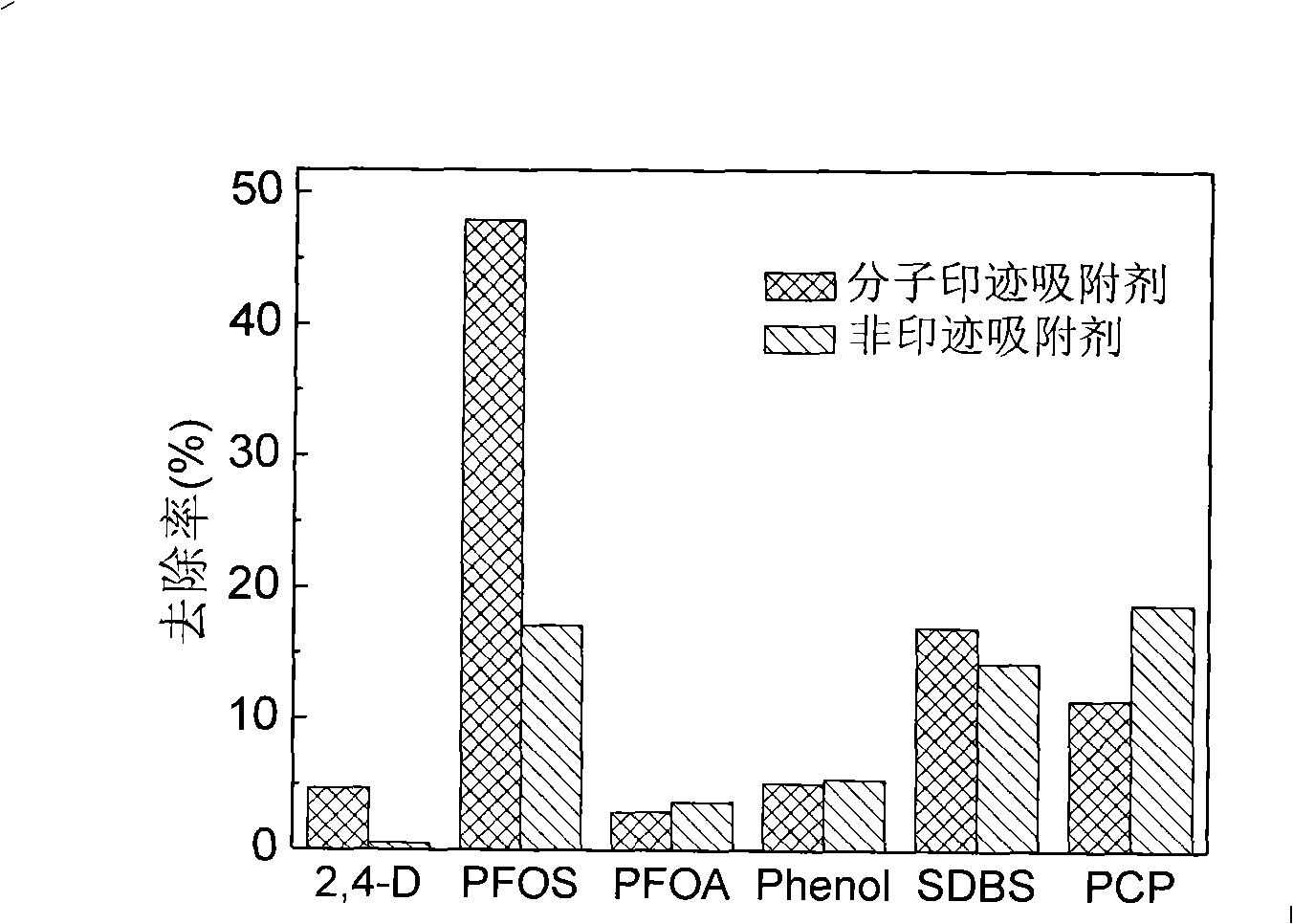Preparation of chitosan molecular imprinting adsorbing agent
A technology of molecular imprinting and chitosan, which is applied in chemical instruments and methods, adsorption water/sewage treatment, and other chemical processes, can solve the problem of reduced adsorption effect and achieve good adsorption specificity and selectivity.
- Summary
- Abstract
- Description
- Claims
- Application Information
AI Technical Summary
Problems solved by technology
Method used
Image
Examples
Embodiment 1
[0027] Example 1: Dissolve 1.5g of chitosan in 50ml of acetic acid solution (volume percentage 2%), and then drip into 200ml of sodium hydroxide (0.5M) solution for granulation after being completely dissolved, and obtain chitosan The pellets are about 36g, and after reacting with 1ml epichlorohydrin at 60°C for 12h, they are washed and stored in deionized water for later use. Take 9g of micro-crosslinked chitosan pellets and add it to 500mL potassium perfluorooctane sulfonate acidic aqueous solution (400mg / L) for 5h, and the pH value of the solution is always kept at about 4. After the blotting, the chitosan pellets were added to the epichlorohydrin solution and reacted at 60° C. for 12 hours. The epichlorohydrin solution contained 0.3 mL epichlorohydrin and 10 ml deionized water. Then, it was eluted with methanol / 0.5M potassium hydroxide solution for 1 hour to remove the template molecules, and finally washed repeatedly with deionized water, freeze-dried to constant weight, and ...
Embodiment 2
[0028] Example 2: Dissolve 3g of chitosan in 100ml of acetic acid solution (volume percentage 2%), and then drip into 400ml of sodium hydroxide (0.5M) solution to granulate after being completely dissolved. The ball is about 72g, reacted with 0.9ml epichlorohydrin at 40°C for 2h, then washed and stored in deionized water for later use. Take 4g of micro-crosslinked chitosan beads and add it to 125mL of potassium perfluorooctane sulfonate acidic aqueous solution (400mg / L) for 5h, and the pH value of the solution is always kept at about 4. After the blotting, the chitosan pellets were added to the epichlorohydrin solution and reacted at 60°C for 5 hours. The epichlorohydrin solution contained 0.15mL epichlorohydrin and 10ml deionized water. Then, it was eluted with acetone / 0.5M sodium hydroxide solution for 3 hours to remove the template molecules, and finally washed repeatedly with deionized water, freeze-dried to constant weight, and chitosan molecularly imprinted adsorbent was obt...
Embodiment 3
[0029] Example 3: Dissolve 3g of chitosan in 100ml of acetic acid solution (volume percentage 2%), after completely dissolved, drip into 500ml of sodium hydroxide (0.5M) solution to granulate, the obtained chitosan is small The ball is about 72g. After reacting with 2ml epichlorohydrin at 40°C for 12h, it is washed and stored in deionized water for later use. 3.36g micro-crosslinked chitosan beads were added to 125mL perfluorooctanesulfonic acid aqueous solution (500mg / L) and blotted for 13.5h. The pH value of the solution was always kept at about 4. After the blotting, the chitosan pellets were added to the epichlorohydrin solution and reacted at 40°C for 12 hours. The epichlorohydrin solution contained 0.4mL epichlorohydrin and 10ml deionized water. Then, it was eluted with methanol / 0.5M sodium hydroxide solution for 3 hours to remove the template molecules, and finally washed repeatedly with deionized water, freeze-dried to constant weight, and chitosan molecularly imprinted ad...
PUM
| Property | Measurement | Unit |
|---|---|---|
| concentration | aaaaa | aaaaa |
Abstract
Description
Claims
Application Information
 Login to View More
Login to View More - R&D
- Intellectual Property
- Life Sciences
- Materials
- Tech Scout
- Unparalleled Data Quality
- Higher Quality Content
- 60% Fewer Hallucinations
Browse by: Latest US Patents, China's latest patents, Technical Efficacy Thesaurus, Application Domain, Technology Topic, Popular Technical Reports.
© 2025 PatSnap. All rights reserved.Legal|Privacy policy|Modern Slavery Act Transparency Statement|Sitemap|About US| Contact US: help@patsnap.com

